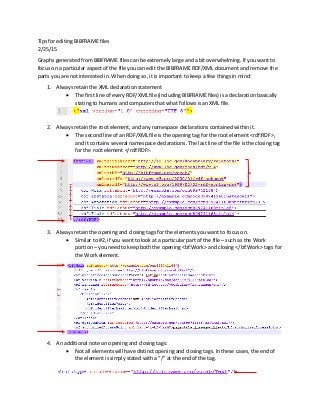Reimagining Serials handout: Tips for editing BIBFRAME files
Starting in late 2014, the UCLA Continuing Resources Study Group began studying semantic web concepts in general and the BIBFRAME vocabulary specifically. Our goal was to understand how things would work for serials and integrating resources in the new linked data environment, to contribute to the discussion and development of linked data models for bibliographic resources, and (if possible!) to try something new. Using just a few free tools, we were able to convert records from MARC, create linked data graphs, and take the first steps in setting up a demonstration triple store. You can too! See the poster http://www.slideshare.net/NASIG/great-idea-reimagining-serials-small-steps-toward-a-linked-data-future Kevin Balster ERM/Continuing Resources Metadata Librarian, UCLA Kevin Balster is the ERM/Continuing Resources Metadata Librarian at UCLA. He received his MLIS from UCLA in 2011, and has been cataloging serials and maintaining e-resources since 2012.

Recommended
Recommended
More Related Content
More from NASIG
More from NASIG (20)
Recently uploaded
Recently uploaded (20)
Reimagining Serials handout: Tips for editing BIBFRAME files
- 1. Tips for editing BIBFRAME files 2/25/15 Graphs generated from BIBFRAME files can be extremely large and a bit overwhelming. If you want to focus on a particular aspect of the file you can edit the BIBFRAME RDF/XML document and remove the parts you are not interested in. When doing so, it is important to keep a few things in mind: 1. Always retain the XML declaration statement • The first line of every RDF/XML file (including BIBFRAME files) is a declaration basically stating to humans and computers that what follows is an XML file. 2. Always retain the root element, and any namespace declarations contained within it. • The second line of an RDF/XML file is the opening tag for the root element <rdf:RDF>, and it contains several namespace declarations. The last line of the file is the closing tag for the root element </rdf:RDF>. 3. Always retain the opening and closing tags for the elements you want to focus on. • Similar to #2, if you want to look at a particular part of the file – such as the Work portion – you need to keep both the opening <bf:Work> and closing </bf:Work> tags for the Work element. 4. An additional note on opening and closing tags: • Not all elements will have distinct opening and closing tags. In these cases, the end of the element is simply stated with a “/” at the end of the tag.
- 2. 5. Some data is not found completely inside the element you are looking at. It may refer to a different part of the file where it is more explicitly stated. • Rather than elaborating, how about an example? If you want to see what the work title is for a particular resource, that data is not fully contained within the Work element. Rather, it simply references a URI that is found further down in the file in a separate Title element. Brief glossary (terms adapted from Library Juice Academy) XML Structure: Here's a simple XML fragment as an example. <?xml version="1.0" encoding="UTF-8"?> <root xmlns:prefix = "namespace URI"> <parent> <child>some text</child> </parent> <parent> <child>some more text</child> </parent> </root> <?xml version="1.0" encoding="UTF-8"?> <booklist xmlns:dc = "http://purl.org/dc/elements/1.1/"> <book1> <dc:title>The paper mixtape</dc:title> </book1> <book2> <dc:title>Cakeboy</dc:title> </book2> </booklist> Element: An element consists of an opening tag, a closing tag, and anything in between the opening and closing tag… Example: <message>It was a dark and stormy night.</message> In this segment, the opening tag is <message> and the closing tag is </message> Attribute: An attribute provides more information about an element. [Note that both element and attribute are terms related to XML, not to linked data. They are only needed because XML is a commonly-used way to represent linked data graphs.] Root element, parent element, child element: It's useful to think of XML documents as a hierarchical tree. The root element is the first element to appear; the root encloses all other elements. Each XML file must have one and only one root. Below the root are parent, child, and subchild elements. Declaration: An XML declaration is a processing statement that appear at the top of an XML document. It must remain in any XML document Example: <?xml version="1.0" encoding="UTF-8" standalone="no" ?> Namespace: XML Namespaces provide a way to create uniquely named elements and attributes in an XML document. Namespaces have two primary uses: to avoid name collisions and to facilitate name recognition. Namespaces are declared by stating the prefix that will be used and a unique URI (commonly, but not exclusively, in the form of a URL).
